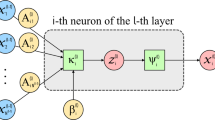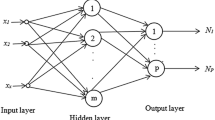Abstract
Traditional neural network is a nonlinear dynamic system formed by a large number of neurons connected to each other, it can be widely used in many research fields, such as data mining, system identification and intelligent control. The neural networks can not only deal with data problems through the unique thinking of the human brain, but can also solve the multi input and multi output problem which is difficult to be completed by the traditional computer. In this paper, in the sense of an equidistance dissection of two-dimensional input space, some new connection weights and thresholds are determined by the interpolations and arithmetic mean values of some data pairs at the adjacent intersecting points, respectively, and a new forward interpolation neural network is constructed by a step path of two-dimensional dissection. Secondly, it is proved that the interpolation neural network can approximate to a continuous function by using characteristic properties of a Sigmoidal activation function. Finally, the approximation performance of the constructed network is tested in the light of the t- hypothesis test method in statistical inference, and the approximation errors of the interpolation network are compared with that of another polynomial neural network.













Similar content being viewed by others
Explore related subjects
Discover the latest articles, news and stories from top researchers in related subjects.References
Cao, F.L., Xu, Z.B., Liang, J.Y.: Approximation of polynomial functions by neural network: construction of network and algorithm of approximation. Chin. J. Comput. 26(8), 907–912 (2003)
Wang, J.J., Xu, Z.B.: Approximation method of multivariate polynomials by feed-forward neural networks. Chin. J. Comput. 32(12), 2482–2488 (2009)
Llanas, B., Sainz, F.J.: Constructive approximate interpolation by neural networks. J. Comput. Appl. Math. 188, 283–308 (2006)
Xu, Z.B., Cao, F.L.: Simultaneous Lp-approximation order for neural networks. Neural. Net. 18(7), 914–923 (2005)
Cao, F.L., Zhang, Y.Q.: Interpolation and approximation by neural networks in distance space. Acta Math. Sinica. 51(1), 91–98 (2008)
Cao, F.L., Xie, T.F., Xu, Z.B.: The estimate for approximation error of neural networks: a constructive approach. Neurocomputing 71(4–6), 626–630 (2008)
Deng, J., Guo, J., Wang, Y.: A novel K-medoids clustering recommendation algorithm based on probability distribution for collaborative fifiltering. Knowl. Based Syst. 175, 96–106 (2019)
Yang, M.S., Chang-Chien, S.J., Nataliani, Y.: Unsupervised fuzzy model-based Gaussian clustering. Inform. Sci. 481, 1–41 (2018)
Hashemzadeh, M., Oskouei, A.G., Farajzadeh, N.: New fuzzy C-means clustering method based on feature-weight and cluster weight learning. Appl. Soft Comput. 78, 324–345 (2019)
Huang, F., Tie, B., Tao, J., Tan, X.C., Ma, Y.: Methodology and optimization for implementing cluster based parallel geospatial algorithms with a case study. Clust. Comput. 23, 673–704 (2020)
Wang, L., Ma, Y., Yan, J., Chang, V., Zomaya, A.Y.: pips Cloud: high performance cloud computing for remote sensing big data management and processing. Fut. Gener. Comput. Syst. 78, 353–368 (2018)
Sánchez, D., Melin, P., Castillo, O.: Comparison of particle swarm optimization variants with fuzzy dynamic parameter adaptation for modular granular neural networks for human recognition. J. Intell Fuzzy Syst. 38(3), 3229–3252 (2020)
Wiktorowicz, K., Krzeszowski, T.: Training high-order Takagi-Sugeno fuzzy systems using batch least squares and particle swarm optimization. Int. J. Fuzzy Syst. 22(1), 22–34 (2020)
Sundari, M.G., Rajaram, M., Balaraman, S.: Application of improved firefly algorithm for programmed PWM in multilevel inverter with adjustable DC sources. Appl. Soft Comput. 41, 169–179 (2016)
Nyathi, T., Pillay, N.: Comparison of a genetic algorithm to grammatical evolution for automated design of genetic programming classification algorithms. Exp. Syst. Appl. 104, 213–234 (2018)
Liang, W.H., He, J.H., Wang, S.X., Yang, L., Chen, F.: Improved cluster collaboration algorithm based on wolf pack behavior. Clust. Comput. 22, 6181–6196 (2019)
Khan, S.A., Mahmood, A.: Fuzzy goal programming-based ant colony optimization algorithm for multi-objective topology design of distributed local area networks. Neural. Comput. Appl. 31(7), 2329–2347 (2019)
Liu, P.Y.: A new Fuzzy neural networks and its approximation capability. Sci. China (E) 32(1), 76–86 (2002a)
Wang, G.J., Li, X.P.: Universal approximation of polygonal fuzzy neural networks in sense of K-integral norms. Sci. China 54(11), 2307–2323 (2011)
Wang, G.J., Li, D.: Capability of universal approximation of feed-forward regular fuzzy neural networks in K -integral norm. Acta Math. Appl. Sinica 36(1), 141–151 (2013)
He, Y., Wang, G.J.: Conjugate gradient algorithm of the polygonal fuzzy neural networks. Acta Electr. Sinica. 40(10), 2079–2084 (2012)
Yang, Y.Q., Wang, G.J., Yang, Y.: Parameters optimization of polygonal fuzzy neural networks based on GA-BP hybrid algorithm. Int J Mach Learn Cybem. 5(5), 815–822 (2014)
Wang, G.J., Li, X.P.: Construction of the polygonal fuzzy neural network and its approximation based on K-integral norm. Neural Net. World 24(4), 357–376 (2014)
Wang, G.J., He, Y., Li, X.P.: Optimization algorithms for MISOpolygonal fuzzy neural networks. Sci. China 45(5), 650–667 (2015)
Wang, G.J., Suo, C.F.: The isolation layered optimization algorithm of MIMO polygonal fuzzy neural network. Neural. Comput. Appl. 29(10), 721–731 (2018)
Li, X.P., Li, D.: The structure and realization of a polygonal fuzzy neural network. Int. J. Mach Learn Cybem. 7(3), 375–389 (2016)
Wang, D.G., Chen, C.L.P., Song, W.Y., Li, H.X.: Error compensated marginal linearization method for modeling a fuzzy system. IEEE Trans. Fuzzy Syst. 23(1), 215–222 (2015)
Wang, D.G., Song, W.Y., Li, H.X.: Approximation properties of ELM-fuzzy systems for smooth functions and their derivatives. Neurocomputing 149, 265–274 (2015)
Liu, P.Y.: Fuzzy neural network and its application. Beijing Normal University, Beijing (2002b)
Xu, Q.Y., Yang, Y., Zhang, C.J., et al.: Deep convolutional neural network-based autonomous marine vehicle maneuver. Int. J. Fuzzy Syst. 20(2), 687–699 (2018)
Xia, K.J., Yin, H.S., Wang, J.Q.: A novel improved deep convolutional neural network model for medical image fusion. Clust. Comput. 22, 1515–1527 (2019)
Hsu, M.J., Chien, Y.H., Wang, W.Y., et al.: A convolutional fuzzy neural network architecture for object classification with small training database. Int. J Fuzzy Syst. 22(1), 1–10 (2020)
Javaid, M., Cao, J.: Computing topological indices of probabilistic neural network. Neural. Comput. Appl. 30, 3869–3876 (2018)
Leng, X.K., Jiang, H.J., Zou, X.: Human action tracking design of neural network algorithm based on GA-PSO in physical training. Clust. Comput. 22, 4149–4155 (2019)
Waddsh, W., Rozaida, G.: A novel error-output recurrent neural network model for time series forecasting. Neural. Comput. Appl. 32, 9621–9647 (2020)
Wang, G.J.: Polygonal fuzzy neural network and fuzzy system approximation. Scientific Press, Beijing (2017)
Funding
This work has been supported by National Natural Science Foundation of China (Grant No. 61374009).
Author information
Authors and Affiliations
Corresponding author
Additional information
Publisher's Note
Springer Nature remains neutral with regard to jurisdictional claims in published maps and institutional affiliations.
Rights and permissions
About this article
Cite this article
Wang, G., Xiao, W. & Tao, Y. Interpolation neural network constructed by the step path and its approximation performance. Cluster Comput 24, 1397–1411 (2021). https://doi.org/10.1007/s10586-020-03197-w
Received:
Revised:
Accepted:
Published:
Issue Date:
DOI: https://doi.org/10.1007/s10586-020-03197-w




